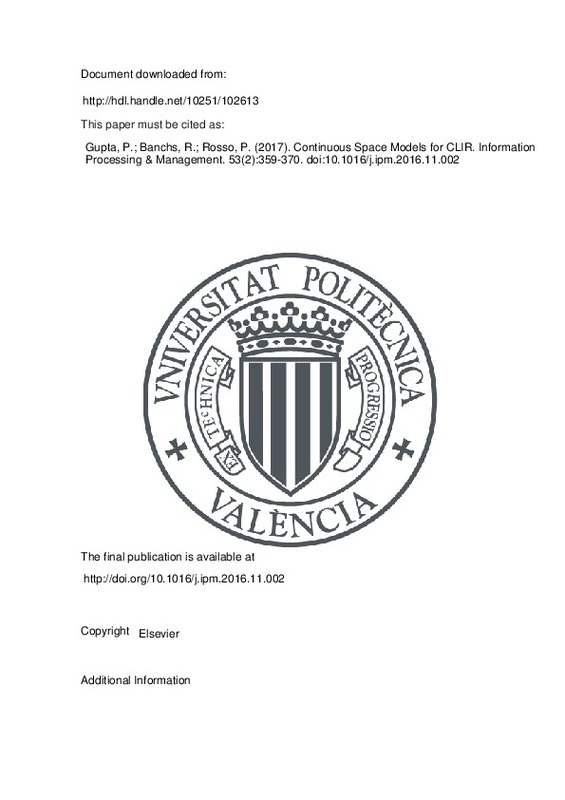JavaScript is disabled for your browser. Some features of this site may not work without it.
Buscar en RiuNet
Listar
Mi cuenta
Estadísticas
Ayuda RiuNet
Admin. UPV
Continuous Space Models for CLIR
Mostrar el registro sencillo del ítem
Ficheros en el ítem
| dc.contributor.author | Gupta, Parth
|
es_ES |
| dc.contributor.author | Banchs, Rafael
|
es_ES |
| dc.contributor.author | Rosso, Paolo
|
es_ES |
| dc.date.accessioned | 2018-05-25T04:21:30Z | |
| dc.date.available | 2018-05-25T04:21:30Z | |
| dc.date.issued | 2017 | es_ES |
| dc.identifier.issn | 0306-4573 | es_ES |
| dc.identifier.uri | http://hdl.handle.net/10251/102613 | |
| dc.description.abstract | [EN] We present and evaluate a novel technique for learning cross-lingual continuous space models to aid cross-language information retrieval (CLIR). Our model, which is referred to as external-data composition neural network (XCNN), is based on a composition function that is implemented on top of a deep neural network that provides a distributed learning framework. Different from most existing models, which rely only on available parallel data for training, our learning framework provides a natural way to exploit monolingual data and its associated relevance metadata for learning continuous space representations of language. Cross-language extensions of the obtained models can then be trained by using a small set of parallel data. This property is very helpful for resource-poor languages, therefore, we carry out experiments on the English-Hindi language pair. On the conducted comparative evaluation, the proposed model is shown to outperform state-of-the-art continuous space models with statistically significant margin on two different tasks: parallel sentence retrieval and ad-hoc retrieval. | es_ES |
| dc.description.sponsorship | We thank German Sanchis Trilles for helping in conducting experiments with machine translation. We gratefully acknowledge the support of NVIDIA Corporation with the donation of the GeForce Titan GPU used for this research. The research of the first author was supported by FPI grant of UPV. The research of the third author is supported by the SomEMBED TIN2015-71147-C2-1-P MINECO research project and by the Generalitat Valenciana under the grant ALMAMATER (PrometeolI/2014/030). | en_EN |
| dc.language | Inglés | es_ES |
| dc.publisher | Elsevier | es_ES |
| dc.relation.ispartof | Information Processing & Management | es_ES |
| dc.rights | Reserva de todos los derechos | es_ES |
| dc.subject | Cross-language information retrieval | es_ES |
| dc.subject | Latens space models | es_ES |
| dc.subject.classification | LENGUAJES Y SISTEMAS INFORMATICOS | es_ES |
| dc.title | Continuous Space Models for CLIR | es_ES |
| dc.type | Artículo | es_ES |
| dc.identifier.doi | 10.1016/j.ipm.2016.11.002 | es_ES |
| dc.relation.projectID | info:eu-repo/grantAgreement/MINECO//TIN2015-71147-C2-1-P/ES/COMPRENSION DEL LENGUAJE EN LOS MEDIOS DE COMUNICACION SOCIAL - REPRESENTANDO CONTEXTOS DE FORMA CONTINUA/ | es_ES |
| dc.relation.projectID | info:eu-repo/grantAgreement/GVA//PROMETEOII%2F2014%2F030/ES/ Adaptive learning and multimodality in machine translation and text transcription/ | es_ES |
| dc.rights.accessRights | Abierto | es_ES |
| dc.date.embargoEndDate | 2019-04-01 | es_ES |
| dc.contributor.affiliation | Universitat Politècnica de València. Departamento de Sistemas Informáticos y Computación - Departament de Sistemes Informàtics i Computació | es_ES |
| dc.description.bibliographicCitation | Gupta, P.; Banchs, R.; Rosso, P. (2017). Continuous Space Models for CLIR. Information Processing & Management. 53(2):359-370. https://doi.org/10.1016/j.ipm.2016.11.002 | es_ES |
| dc.description.accrualMethod | S | es_ES |
| dc.relation.publisherversion | http://doi.org/10.1016/j.ipm.2016.11.002 | es_ES |
| dc.description.upvformatpinicio | 359 | es_ES |
| dc.description.upvformatpfin | 370 | es_ES |
| dc.type.version | info:eu-repo/semantics/publishedVersion | es_ES |
| dc.description.volume | 53 | es_ES |
| dc.description.issue | 2 | es_ES |
| dc.relation.pasarela | S\326664 | es_ES |
| dc.contributor.funder | Generalitat Valenciana | es_ES |
| dc.contributor.funder | Ministerio de Economía, Industria y Competitividad | es_ES |







![[Cerrado]](/themes/UPV/images/candado.png)

